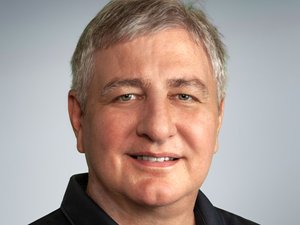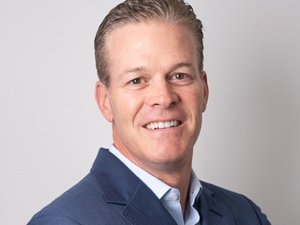DC Water's approach to social media can be summed up in one tweet from September: "Our first plan was to agree and blame it all on @DDOTDC," the municipal agency wrote in reply to a user complaining about a bike lane blocked by construction equipment. "But instead, we're making some changes we hope will help." This formula of one part Twitter snark and one part responsive customer engagement defines DC Water's social media strategy under Chief of External Affairs John Lisle.
The independent authority, which is responsible for providing drinking water and sewer management across the District, has used social media to engage with customers and establish itself as a unique online voice. In 2015, the @dcwater Twitter account was picked by Washington City Paper as the best government Twitter account, and its lighthearted exchanges with other municipal agencies, local media and customers add levity to the monotony of responding to reports of water main leaks.
In his tenure as Chief of External Affairs, John Lisle has presided over that social media strategy. Since 2014, he's helped double the agency's Twitter following to over 13,000 followers, expand engagement and usage on Facebook and Instagram and experiment with new media like Snapchat. And seeing the value in a responsive social media presence, Lisle and DC Water have hired a digital communications manager dedicated to maintaining and growing that online brand. We spoke with Lisle about his tenure at DC Water and the importance of staying fresh and relevant online.
How did you end up at DC Water?
I was working at DDOT (District Department of Transportation) and was there for 4 and a half years. Alan Heymann, who held my position previously, left to take a dream job for him, at the Humane Society. That opened up the spot and that’s how I got here. DC Water is still government, but since we’re an independent agency, it’s a little different that being a government agency like DDOT. We have our own budget, our own employment system, etc.
Would you say that gives you more freedom?
It kind of cuts both ways. We tried to be edgy and experiment at DDOT with social media. Here there’s a little more distance from government and a little more independence.
At the same time, we’re completely ratepayer funded so we have customers—actual bill paying customers. When I got here, I was more tuned in to that and a little more apprehensive. I didn’t just say “oh I did this at DDOT so i can be as snarky right off the top.” You have to establish a voice for yourself over time.
You’ve managed to drive a social media strategy that is both lighthearted and at the same time responsive. How has this paid off as a public agency?
You can try to be fun, be involved and do the fun stuff, but first of all you need to do your job and be responsive to people
I think it’s worked very well. As Andy [Le, former DC Water Digital Communications Manager] used to say, you gotta do your job first, and then you can do some of the other stuff. That kind of defines the strategy. You can try to be fun, be involved and do the fun stuff, but first of all you need to do your job and be responsive to people.
You might be answering tweets on your day off, on the weekend, that’s part of it. You have to do that first then you can do the other stuff. But you also want to build an audience. If your responses get attention, that helps to build your audience.
Municipal water departments might not seem like a natural place for an intersection of technology and social media snark. How do you stay creative and where do you find inspiration?
Wendy, for one thing [DC Water’s water drop mascot]. Using the mascot in different things that people wouldn’t expect. It’s not just giving Wendy a little bit of an edge. Being funny, a little irreverent, I think that’s helped.
One of the ways we’ve tried to stand out it, and it goes back to being responsive, is cutting through the bureaucracy. Somebody might be frustrated because they can’t get through to customer service. If we can respond to them immediately on Twitter, we might be able to fix their problem immediately, but at least they know they are being heard and we’re working on a fix.
Another thing is, our General Manager George Hawkins is looking at Twitter every day. He wasn’t on it when I first got here, he is now. And he supports it and he brags about it; he’s now on Twitter, and he’s learning how to have his own voice. But he’s supportive of what we do, and that is really helpful.
Going back to what you said early about being responsive to customers. How do you balance a nimble communications team with operations that might not be able to move as quickly?
That’s certainly one of the challenges. On the back end for us, our social media is not in customer service. A lot of large businesses might integrate that in customer service but that’s not for us. What’s important for us is building the relationship between our communications team and customer service. Whether it’s a billing issue, a truck in bike a lane or a water main break, we try to build relationships so we know who to go to and say “this person has higher bill can you look into it.” It just requires building those internal relationships.
You can’t always make things happen right away. Sometimes people will report a leak, but if it’s a slow leak, it might not get fixed right away. Part of what we do is explaining that to them, what the other priorities are. It’s education just as much as it’s communication—trying to represent DC Water and why we operate the way we operate.
It’s education just as much as it’s communication
People like to hate on tap water in pretty much every city. How do you convince them it’s not that bad?
The main messages that we try to stick to are that water is affordable, especially compared to bottled water. In my opinion, it tastes good and if you don’t think so you can filter it. It’s environmentally friendly, the amount of energy to produce bottled water is far higher and ? bottles end up in landfills.
A big challenge is, right now with the lead crisis in Flint and our own lead crisis in early 2000s, is whether the water is safe. There’s a lot of uncertainty sometimes, but a lot of opportunity for us to educate on the difference between us and bottled water. It’s a constant thing, but part of that is on us to make sure we’re sharing info any way we can on why tap water is good. When you look at tap versus bottled water, tap quality is far more closely regulated and it’s cheaper.
Who else in DC, be it person, agency, organization or business, do you admire?
I think the DC libraries have done a very good job, even though we’ve had our fake battles with them on social media, of communicating with customers, having conversations about books and reading. I think that’s a great example of agency that is having meaningful conversation with customers.
The way police departments are now using social media are interesting to me. From 2006 to 2008 I worked for the Arlington County Police, and what we had at that time was Myspace and YouTube. And we used them both. We’d post videos on YouTube of surveillance tape. We used Myspace to scare off child predators. But there was a lot of resistance at that time to social media, and it’s great to see how departments like Prince George’s, Alexandria, Fairfax County have embraced social media as a way to communicate with their communities.
What would say to other agencies about using social media?
It’s gone from, “you should be doing social media as an add on,” to now it’s what everyone is doing.
What we did at DC Water was create a digital communication manager position. If you really want to be effective, you should have someone who is fully dedicated to creating content, having conversations with customers and deciding what our strategy is.
We’re on Snapchat now, still figuring out how it works, how people use it. But it’s the same as everything else: if a large number of potential customers are on it, you need to be too. Part of it is trying to keep up. We’re experimenting with Snapchat and Facebook Live, trying to figure out what’s next and where we should be dedicating our resources.
What makes D.C. and the D.C. government a unique place to work?
I think the city is going through a very interesting time period, with the growth in the city, the change in the city in adding so many new residents and so much development. It’s a very exciting city.
Something that’s always on my mind as someone who is serving the entire city, is making sure that you’re communicating with everybody. Old, new, affluent, needy residents, that to me makes it very unique. Especially in a time of change, when things are more expensive and there’s a lot of talk about gentrification, that makes it an interesting time and an important one to be reaching everyone.
In the time I’ve been in the DC government, it’s become a lot more efficient and effective in serving residents. They demand more and they should. What we’re doing should be expected. If we’re doing a good job communicating, that should be expected. I’ve seen a lot of positive things happening in government, and I feel like the city is in a good place and it’s been exciting to be a part of it.




